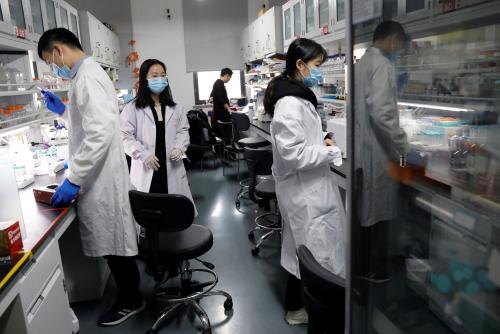On behalf of the Brookings Institution-SAIS Project on Internal Displacement, I want to express my and my colleagues’ pleasure at being invited to participate in this International Workshop on Migration in West Africa. As you know, I co-direct the Brookings-SAIS Project together with Francis Deng, Representative of the United Nations Secretary-General on Internally Displaced Persons. Erin Mooney is the Deputy Director of the Project, and Marianne Makar is a senior researcher. The Brookings Institution, I should explain, is a research institution or “think tank” in Washington DC. It joined hands with the Johns Hopkins University School of Advanced International Studies to form a project to support the mandate of the Representative of the Secretary-General.
The Representative was appointed in 1992 at the request of the UN Commission on Human Rights because of the growing worldwide crisis of internal displacement. At the time of his appointment, an estimated 25 million people in Africa, Asia, the Americas and Europe were reported to be forcibly uprooted within their own countries by internal conflicts, communal violence and violations of human rights. Because they had not crossed an international border, they were not part of the well-established legal and institutional framework created internationally and regionally for refugees. Being displaced inside their countries, they often went without the very basics of survival. Many remained engulfed in conflicts, exposed to severe threats to their physical security, and in need of food, medicine and shelter.
The UN therefore asked the Representative to study the phenomenon of internal displacement—its causes, consequences, numbers and needs—and to recommend ways to promote greater protection and assistance for these populations. What had become clear was that internally displaced people had begun to outnumber refugees two to one in emergency situations.
You might ask why there was readiness to deal with situations of internal displacement in the last ten years of the 20th century but not before. Several reasons explain this. Most notably, traditional notions of sovereignty began to change. To be sure, primary responsibility for internally displaced persons was acknowledged to rest with their governments. But it also began to be acknowledged that when governments were unable or unwilling to provide for the wellbeing and security of their populations and large numbers were at risk, regional and international organizations had a role to play as well.
A second reason why internal displacement came onto the international agenda was the realization that millions of people caught up in civil wars without the basic necessities of life were not only disrupting the stability of their own countries but were also undermining regional and international security. This has special relevance to West Africa where conflict and displacement in one country so easily spills over borders, overwhelming neighboring countries with refugees and helping to ignite regional wars. UN Secretary-General Kofi Annan, who comes from West Africa, has warned the international community that if left unaddressed, internal displacement could upset regional stability. He has urged the international community to lend support to national efforts to assist and protect displaced populations.
Still another important reason why internal displacement gained prominence was the realization that peace and reconstruction in war-torn societies could not take place without the effective reintegration of displaced persons. Many of the countries devastated by civil war have anywhere from one third to three quarters of their population forcibly uprooted. That has especially been the case in West Africa where the majority of the population in some countries has become uprooted, even multiple times. It therefore became impossible to talk about reconstruction and development without taking into account the return, resettlement and reintegration of refugees and internally displaced persons.
Because of this new international focus, the role that international organizations have come to play in monitoring situations of internal displacement and trying to help those uprooted has clearly expanded. Over the past decade, a multitude of humanitarian, human rights and development agencies have come forward to try to provide protection, assistance and reintegration support to displaced populations. These include the International Committee of the Red Cross, the UN High Commissioner for Refugees, the International Organization for Migration, UNICEF, the World Food Program, and the UN Development Program. In January of this year, a special unit on internal displacement was created within the UN Office for the Coordination of Humanitarian Affairs. I would note that the Office visited Liberia, Sierra Leone and Guinea this year.
The role of the Representative of the Secretary-General has also expanded. Dr. Deng regularly engages in dialogues with governments about their policies and programs toward the internally displaced and visits countries affected by internal displacement. Together with international legal experts from different parts of the world, he developed guidelines to assist governments and other actors in working with the internally displaced. They are called the Guiding Principles on Internal Displacement, and my colleagues on the panel will discuss their content as well as their standing and use. What I would like to emphasize here is that the Guiding Principles are a tool designed to help governments when they frame policies, adopt laws, monitor conditions and collect information.
This meeting has as one of its primary purposes the need to harmonize data collection about migrants in the region. We are pleased that the subject of forced migrants, in particular the internally displaced, are being integrated into this effort. Credible information about internally displaced persons is essential to effective policies, programs and laws. We must know the numbers and conditions of the displaced in order to help them. But the fact of the matter is that too much of the information about internally displaced persons worldwide is based not on estimates, but guess-timates, or guesses, since the displaced are often not counted individually and large numbers may be inaccessible to outsiders
Because it is important to overcome this information gap, let us look at some of the challenges to collecting data about the internally displaced. To begin with, not all displaced persons are easily accessible in camps where they can be registered. Large numbers may merge into local communities or urban areas. Others may hide and not want to be identified fearing for their safety. Even in camps, there may be multiple registrations and persons living around the camps may claim to be displaced in order to receive benefits. Governments for their part have sometimes been known to understate numbers of displaced persons in order to deny the magnitude of the problem; they have also been known to sometimes inflate the numbers for a variety of reasons. There are also differences of opinion about when displacement ends, whether persons are reintegrated or whether they remain internally displaced, whether persons not in camps should be considered internally displaced. There is confusion in reporting as well. Newspaper articles frequently give totals of refugees when they mean internally displaced persons and sometimes rural to urban migration is mistakenly counted as internal displacement. However, rather than be paralyzed by these challenges, this workshop offers an opportunity to begin to address the problems through a harmonized approach to data collection that includes internal displacement.
It is also important to bear in mind the special problems in collecting information about displaced populations who live in areas controlled by insurgent groups. In one country of West Africa, up to 30 percent of the country remains inaccessible to humanitarian workers. Indeed, displaced people living under non-state actors often become invisible or forgotten people whose starvation, sicknesses and protection problems only become known after cease-fires are negotiated. Even in cases where information does leak out, such as the atrocities committed against displaced and other persons by the RUF in Sierra Leone, the politics of the situation or the dangers involved may result in too little being done to reach the people at risk. Sometimes governments prefer that there be no contact by humanitarian agencies with insurgent forces, for fear that this will enhance the rebels’ legitimacy. More time and effort, therefore, needs to be devoted to finding out information about the displaced persons living under insurgent control. Doing so may turn out to be life saving for the people involved. The Representative of the Secretary-General, for example, has found that partnerships between humanitarian organizations, local organizations, and church groups have sometimes proved effective in collecting information about displaced populations living under insurgent groups.
There are a number of non-governmental and UN agencies with considerable experience in gathering data about displaced populations and that can assist governments in their overall efforts. I would note that in West Africa, estimates of displaced populations are especially hard to come by and have sometimes been a subject of controversy. A new Global Survey of Internally Displaced People, published by the Norwegian Refugee Council, emphasizes the widely differing estimates of internal displacement in the West African countries and how specific figures on internal displacement are often lacking. Their latest figures add up to around one million internally displaced persons in the West African region, although they are the first to acknowledge that there is need to improve data collection. In particular, information about internally displaced persons needs to be disaggregated or made specific to vulnerable groups so that the needs of children and adolescents, women heads of household, the disabled and the elderly can be better addressed.
Before closing my remarks, it should be acknowledged that there are some who question whether the internally displaced should be identified as a special category. Their needs, it is said, may be indistinguishable from others around them or that singling out this group could lead to their having a privileged status. But the fact of the matter is that internally displaced persons have special needs because of their displacement, whether they are in camps, have merged into urban slums or hide to avoid identification. The whole purpose of collecting comprehensive and up to date information should be to improve the humanitarian response to their desperate predicament.
Let me emphasize too that when governments become involved in data collection and registration of displaced persons, it is unlike when governments collect statistics about who is entering their territory from abroad. Internally displaced persons are in their own country so that freedom of movement is the key element and must be respected. This suggests that the personnel assigned to collect data on internally displaced persons should be trained in human rights and humanitarian standards, and in displacement issues. They must be sensitive to displaced persons who may be fearful of being identified, who do not have proper documentation, or who are trapped in rebel areas. Unlike refugees who have an interest in registering with the UN and the government so that they will be protected against refoulement, internally displaced persons may have less incentive to register or may not want to make themselves known. The purpose of information collection must therefore be geared to protecting and assisting the internally displaced and helping them find solutions to their plight.
Growing international concern about internally displaced persons is best combined with efforts at the national and regional levels to remedy the problem. By working together with international and local humanitarian actors, government ministries can augment their own capacities in information collection and other important aspects of addressing situations of internal displacement.
Thank you.


Commentary
Internal Displacement: Overview and Information Issues
September 30, 2002